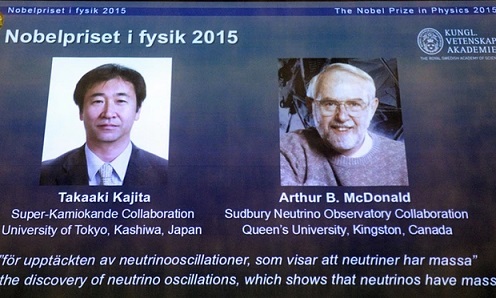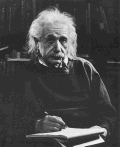|
جایزه نوبل فیزیک به طور مشترک به دو
دانشمند ژاپنی و کانادایی تعلق گرفت
جایزه نوبل فیزیک سال ۲۰۱۵، به طور مشترک به دو دانشمند ژاپنی و
کانادایی، به دلیل کشف آنان در زمینه
"نوترینوها" تعلق گرفت.

آکادمی نوبل در سوئد، روز سهشنبه اعلام کرد که تاکاکی کاجیتا از
دانشگاه توکیو در ژاپن و آرتور مک دانلد از دانشگاه کویینز در
کینگستون کانادا کشف کردهاند که
"نوترینوها" ، ذرات ریزتر از اتم،
دارای جرم هستند.
در بیانیه آکادمی نوبل دراینباره آمده است: "این
کشف درک ما را از کارکرد ماده دگرگون کرده است و میتواند در
برداشت ما از کائنات نیز نقشی حیاتی داشته باشد".
"گوران
هنسن"، دبیر کل آکادمی سلطنتی علوم سوئد درباره اعطای این جایزه
گفت: "آکادمی سلطنتی علوم سوئد تصمیم گرفته است جایزه نوبل سال
۲۰۱۵ را به تاکا آکی کاجیتا و آرتور مک دانلد برای کشف این که
نوترینو ها جرم دارند اهدا کند. این دو دانشمند با کشف نوسانات
ذرات نوترینو توانستند ثابت کنند که این ذرات که از فراوان ترین
ذرات در کائنات هستند دارای جرمند.
همچنین در
نشست خبری اعلام برنده جایزه نوبل فیزیک، پروفسور "آن لولیه" رئیس
کمیته نوبل فیزیک یادآور شد: "هم اکنون در این اتاق بیش از یک
میلیارد نوترینو وجود دارد که تقریبا با سرعت نور حرکت می کنند.
این ذرات بنیادی پس از فتون ها که ذرات نوری هستند."
وی افزود:
"نوترینو فراوان ترین ذرات در کائناتند و در واکنش های هسته ای
برای مثال در خورشید و ستارگان و یا نیروگاه های هسته ای تولید می
شوند. کشف اخیر به این معناست که نوترینو ها که در گذشته تصور می
شد فاقد جرم هستند، دارای جرمند. و از آن جا که شمار آن ها بسیار
زیاد است این کشف، دید ما از کائنات را تغییر می دهد."
این دو
فیزیکدان نه تنها مدال و دیپلم نوبل را دریافت می کنند بلکه جایزه
۸ میلیون کرون سوئدی که معادل ۹۶۲ هزار دلار
Press Release
6 October 2015
The Royal Swedish Academy of Sciences has
decided to award the Nobel Prize in Physics for 2015 to
Takaaki Kajita
Super-Kamiokande Collaboration
University of Tokyo, Kashiwa, Japan
and
Arthur B. McDonald
Sudbury Neutrino Observatory Collaboration
Queen's University, Kingston, Canada
"for the discovery of neutrino oscillations,
which shows that neutrinos have mass"

Press Release
6 October 2015
The Royal Swedish Academy of Sciences has
decided to award the Nobel Prize in Physics for 2015 to
Takaaki Kajita
Super-Kamiokande Collaboration
University of Tokyo, Kashiwa, Japan
and
Arthur B. McDonald
Sudbury Neutrino Observatory Collaboration
Queen's University, Kingston, Canada
"for the discovery of neutrino oscillations,
which shows that neutrinos have mass"
Metamorphosis in the particle world
The Nobel Prize in Physics 2015 recognises Takaaki
Kajita in Japan
andArthur
B. McDonald in
Canada, for their key contributions to the experiments which
demonstrated that neutrinos change identities. This
metamorphosis requires that neutrinos have mass. The discovery
has changed our understanding of the innermost workings of
matter and can prove crucial to our view of the universe.
Around the turn of the millennium, Takaaki Kajita
presented the discovery that neutrinos from the atmosphere
switch between two identities on their way to the
Super-Kamiokande detector in Japan.
Meanwhile, the research group in Canada led by
Arthur B. McDonald could demonstrate that the neutrinos from the
Sun were not disappearing on their way to Earth. Instead they
were captured with a different identity when arriving to the
Sudbury Neutrino Observatory.
A neutrino puzzle that physicists had wrestled
with for decades had been resolved. Compared to theoretical
calculations of the number of neutrinos, up to two thirds of the
neutrinos were missing in measurements performed on Earth. Now,
the two experiments discovered that the neutrinos had changed
identities.
The discovery led to the far-reaching conclusion
that neutrinos, which for a long time were considered massless,
must have some mass, however small.
For particle physics this was a historic
discovery. Its Standard Model of the innermost workings of
matter had been incredibly successful, having resisted all
experimental challenges for more than twenty years. However, as
it requires neutrinos to be massless, the new observations had
clearly showed that the Standard Model cannot be the complete
theory of the fundamental constituents of the universe.
The discovery rewarded with this year's Nobel
Prize in Physics have yielded crucial insights into the all but
hidden world of neutrinos. After photons, the particles of
light, neutrinos are the most numerous in the entire cosmos. The
Earth is constantly bombarded by them.
Many neutrinos are created in reactions between
cosmic radiation and the Earth's atmosphere. Others are produced
in nuclear reactions inside the Sun. Thousands of billions of
neutrinos are streaming through our bodies each second. Hardly
anything can stop them passing; neutrinos are nature's most
elusive elementary particles.
Now the experiments continue and intense activity
is underway worldwide in order to capture neutrinos and examine
their properties. New discoveries about their deepest secrets
are expected to change our current understanding of the history,
structure and future fate of the universe.
Source:
Nobel Prizes Org
عطف به عتف - نگاهی
به پژوهش و ISI در
ایران
امید عمومی - نامه
به ریاست جمهوری
مرز بین ایمان و تجربه
نامه
سرگشاده به حضرت آیت الله هاشمی رفسنجانی
آخرین
مقالات
1 2 3 4 5 6 7 8 9 10 11 12 13 14 15 16 17 18 19 20 21 22 23 24 25
26 27 28 29 30 31 32 33 34 35 36 37 38 39 40
|



